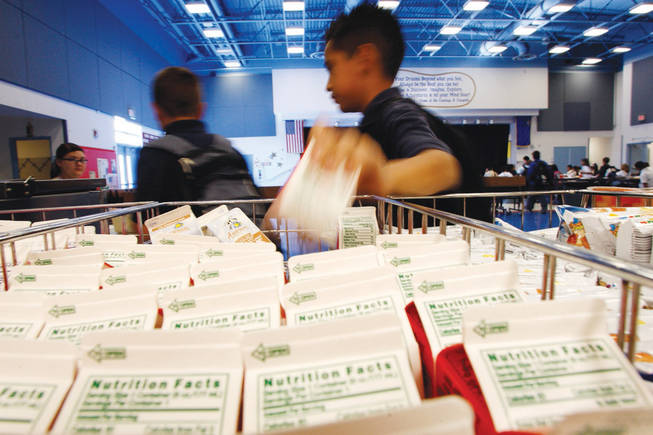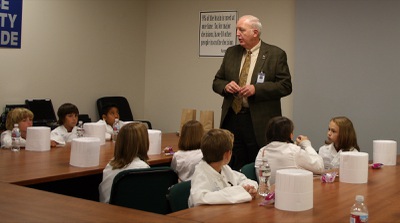
A students grabs a carton of milk to go with his breakfast at Cortez Elementary School last year.
Monday, Sept. 13, 2010 | 2 a.m.
Sun Archives
Each school day, 300,000 high-spirited children and voracious teenagers — virtually a city the size of Pittsburgh — converge on the public schools to eat.
Of these, about 156,000 qualify for free meals.
Now, because of small but telling changes in the school meals program, the Clark County School District expects far more mouths to feed this year, exceeding last year’s record share of 50.3 percent.
Which doesn’t bother Charles Anderson, the district’s director of food services and a former principal at Gragson Elementary School.
“We want to feed hungry children,” he said. “We could feed 100 percent if we had to.”
Because of economies of scale in the giant operations of Clark County, the additional cost of more free meals this year would be, as Anderson puts it, “minuscule.”
And the need is urgent, he said.
The recession is not easing and may be getting worse. Nevada unemployment, the worst in the nation, disrupts lives and hurts the mission of public schools, he said.
With only half of all students graduating from Clark County high schools, hunger is a barrier.
“Most people work better when their stomach is not growling at ’em,” Anderson said. “Kids, adults, anybody. If you’re hungry, you may be thinking about eating, instead of thinking about what you’re doing.”
An important date for low-income parents: Oct. 9.
“A lot of parents mistakenly think that because they received free meals last year, they are automatically rolled over to this year,” Anderson said. “That is not true.”
Every school year parents must apply for their children. What is new this year is that the U.S. Agriculture Department, which administers the free-meals program, has a website that speeds applications.
Low-income parents with access to a computer can qualify their children for meals in two days, instead of the two weeks required for paper and ink applications.
Parents can apply online at applyforlunch.com or get information by calling the district’s free and reduced-price meal benefits department at 1-800-819-7556.
A family of four with annual income of $28,665 or less qualifies for meals.
“Where parents get confused is there is a transition period,” Anderson said. “If a student qualified last year, you will get a free lunch this year for a time, just for a time, to give the parents an opportunity to get approved.”
Applying as early as possible is crucial to getting uninterrupted meals for a child in school. Oct. 12 is the deadline for everything to be completed, not to begin the process.
“That’s why the online application is so important,“ he said.
The number of students qualifying for meal benefits has climbed steadily in the past few years, even before the Nevada economy collapsed in 2008.
In the 2006 school year, the share of students qualifying for free or reduced-price meals reached 42.4 percent, or 126,000 students.
In four years, 30,000 students, equivalent to 10 high schools, had been added.
Last year, to address the crisis, the district experimented with expanding the program, making all meals free rather than charging a third of the price for some of them.
It is continuing that pilot project until at least the end of this school year.
In elementary schools, for paying students, breakfast costs $1.25 and lunch $1.75.
In middle and high schools, the price are $1.50 for breakfast and $3 for lunch.
Ruben Murillo, president of the union representing most of the district’s 18,000 teachers, said it is worrisome that more students need free lunches, but that any program that eases hunger helps teachers do their job.
Murillo suspects there are schools where most students get free meals. Whitney Elementary School, which has about 700 students, also has a food and clothing bank for low-income families, he said.
Alison Turner, president of the Nevada Parent Teacher Association, worries about access. Some poor families struggle with English fluency and don’t have a telephone, let alone a computer and Internet access.
“We have computers at public libraries, but there’s very little drop-in ability,” she said. “You have to make an appointment and there isn’t a library on every corner.”
Moreover, she said, the USDA website “intimidating.” If you are computer-literate, she said the site is “a no-brainer, but not everyone is computer-literate.”
Free or reduced-priced meals date to the Truman administration and the National School Lunch Act. The federal government reimburses local schools for the cost of meals.
Students in Clark County pay for meals with the aid of a computerized student identification number at the cashier.
Free meals and full-price meals are recorded in the same way. There is no separate line for students paying nothing.
Anderson did not want to disclose the food budget but said it totaled several million dollars.
The district’s centralized kitchen covers 27 acres.
There are 1,600 full-time and part-time food service workers to cook and prepare food. Twenty-six trucks and 30 trailers distribute it to more than 350 schools.
Anderson seems to swell with pride when he talks about the system’s capacity.
If all the roads to Las Vegas were cut off and no more food came in, Anderson said, the district could still function with frozen and other food on hand.
“We could feed everybody for 13 days,” he said.


Join the Discussion:
Check this out for a full explanation of our conversion to the LiveFyre commenting system and instructions on how to sign up for an account.
Full comments policy